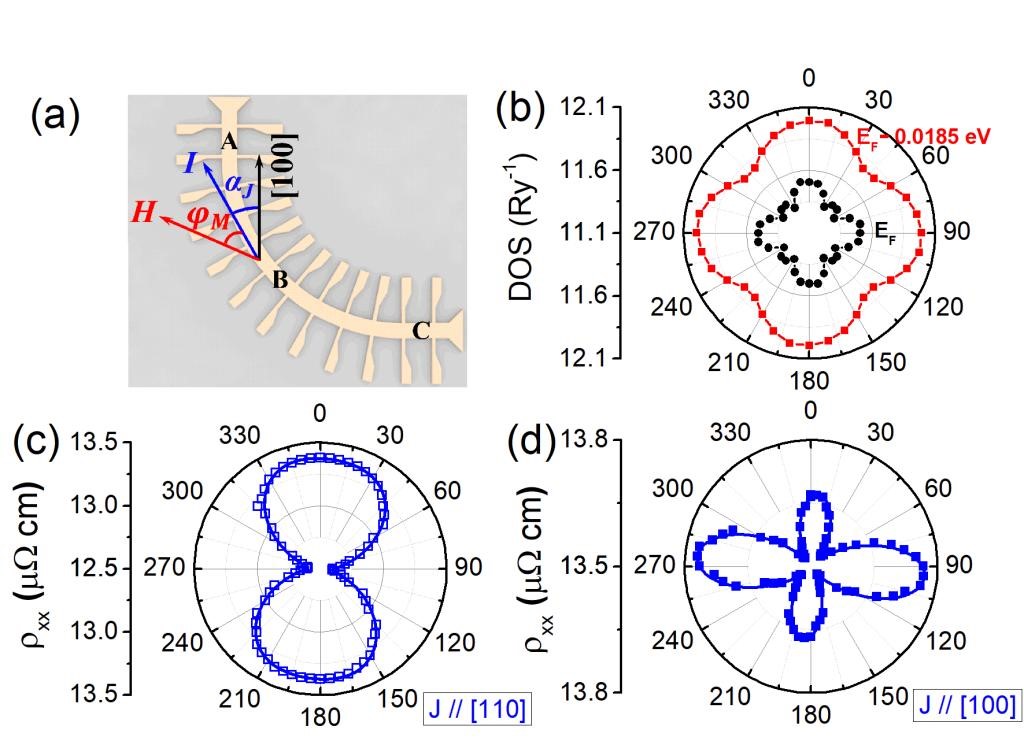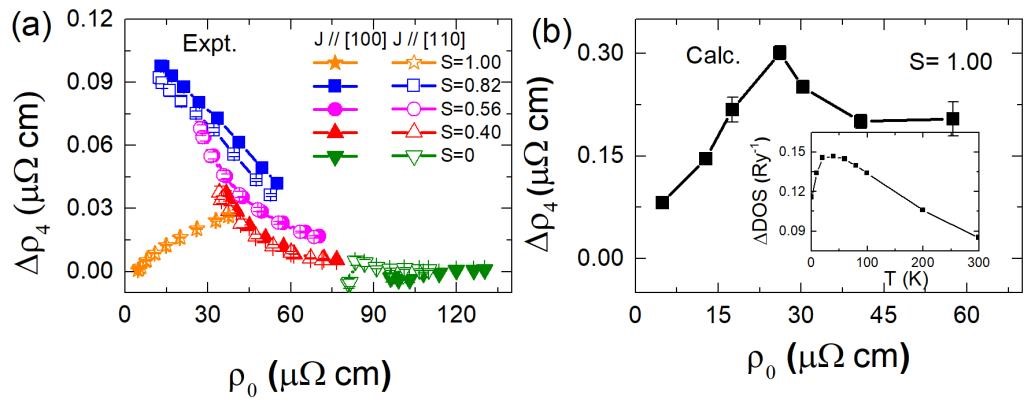Recently, the research team headed by Professor ZHOU Shiming from the School of Physical Science and Engineering of Tongji University and the research team headed by Professor YUAN Zhe from the Center for Advanced Quantum Studies and Department of Physics, Beijing Normal University, have revealed jointly the micro mechanism of fourfold symmetric anisotropic magnetoresistance of Ferromagnetic metal materials. That is, the Fermi surface density of states under rotation of the magnetization is modulated by magnetization direction in the crystal, resulting in the relaxation time anisotropy. Their research paper entitled Fourfold Anisotropic Magnetoresistance of L10 FePt Due to Relaxation Time Anisotropy was published in Physics Review Letters on 15 June 2022.
The resistance of magnetic metals is controlled by the magnetic configuration. The angular dependent anisotropic magnetoresistance is an important cornerstone of spintronics. Anisotropic magnetoresistance describes the change of resistance in ferromagnetic metals with the magnetic orientation. It was first discovered by William Thomson (Lord Kelvin) in 1857 when measuring the resistance of iron and nickel, and is widely used in the field of magnetic sensing. In polycrystal materials, the restriction of symmetry makes the resistance dependent on the angle j between the current orientation and magnetization direction, showing cos2j type second-order symmetry. Since the discovery of cos4j type fourfold symmetrical anisotropic magnetoresistance in single crystal nickel in the 1930s, fourfold symmetries have been confirmed to exist widely in ferromagnetic materials such as single crystal iron, cobalt, iron oxide, manganese oxide and diluted magnetic semiconductors. However, after nearly a century of exploration, people still know little about the micro mechanism of fourfold symmetric anisotropic magnetoresistance.

Figure 1 (a) Anisotropic magnetoresistance measurement of single crystal iron platinum ordered alloy; (b) Change of density of states near Fermi energy with the magnetic direction rotation of the magnetization: when the current is along [110] (c) and [100] (d), the dependence of resistance measured in magnetic direction
The two research teams headed by Professor ZHOU Shiming and Professor YUAN Zhe studied the anisotropic magnetoresistance of L10 phase iron platinum ordered alloy, and separated the changing trend of twofold and fourfold symmetries by changing the alloy order and measuring temperature. The twofold symmetry strongly depends on the current orientation in the crystal, and the change with the order and temperature can be well understood by analyzing the energy structure. More importantly, it is found that the contribution of fourfold symmetry independent of current orientation in the crystal, depends only on the crystal direction of the magnetic moment, and shows a non-monotonic change that increases first and then decreases with the increase of the degree of disorder.
The first-principles calculations reveal that the fourfold AMR arises from the relaxation time anisotropy due to the variation of the density of states near the Fermi energy under rotation of the magnetization. Combined with experimental measurements and theoretical calculations, this study reveals for the first time that the fourfold symmetric anisotropic magnetoresistance originates from the anisotropy of electron relaxation time, which is caused by the fourfold change of Fermi surface density of states. At the same time, the fourfold term is independent of the crystal direction of the current, which becomes the decisive criterion of this mechanism. Furthermore, first-principles calculations reproduce the non-monotonic change of the fourfold symmetry term with the degree of disorder and the monotonic change of the spin orbit coupling intensity in iron platinum ordered alloys. Finally, it should be pointed out that under the spin orbit coupling, the Fermi surface state density modulated by the direction of magnetic moment is a common phenomenon in ferromagnetic metals, so the mechanism proposed in this paper is universal for single crystal Ferromagnetic metals. In addition, the anisotropy of electron relaxation time will also cause the anisotropic behavior of important physical parameters, including magnetic damping.

Figure 2 (a) Experimental measurement of fourfold symmetric anisotropic magnetoresistance; (b) theoretical calculation of the change of fourfold symmetric term of fully ordered iron platinum alloy with resistance. The illustrations shows the anisotropy of Fermi surface density of states at finite temperature
DAI Yu, a doctoral student from the School of Physical Science and Engineering of Tongji University, and ZHAO Yawen, a doctoral student from the Department of Physics of Beijing Normal University, are the co-first authors of the paper, and Professors ZHOU Shiming and YUAN Zhe the co-corresponding authors. Other authors of the paper also include Professor QIU Xuepeng of Tongji University, Dr. MA Li, Dr. TANG Meng and researcher LIU Yi of Beijing Normal University. The research is supported by the National Natural Science Foundation of China and the key R & D Program of the Ministry of Science and Technology.
Link to paper: https://journals.aps.org/prl/abstract/10.1103/PhysRevLett.128.247202